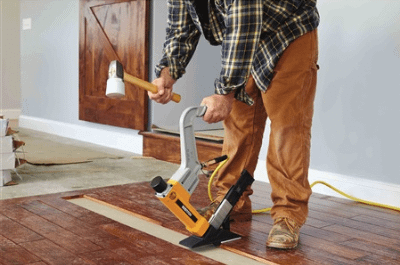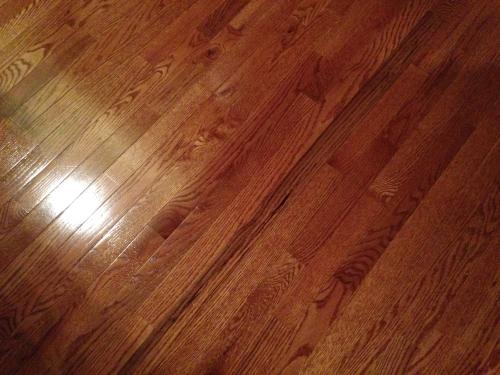6 Critical FAQs Before Installing Hardwood Flooring

Nothing beats the ambiance and timelessness of wood floors. Hardwood flooring can last a hundred years or more, adding beauty and value to your home. Installing hardwood flooring, on the other hand, can be a daunting process if you aren't familiar with the following frequently asked questions.

Q. What’s the difference between hardwood and engineered wood flooring?
Hardwood flooring is made of solid wood. Walnut, cherry, pine, birch, ash, are common varieties of hardwood flooring. Bamboo (actually a grass and not a wood) is another popular flooring choice these days. Engineered wood, often used interchangeably with hardwood flooring, is actually made of layers of wood with a veneer of real wood. It offers the look of solid wood, but with greater versatility.
Solid hardwood flooring typically comes in 3/4” thick boards, while engineered wood boards are usually 3/8" or 1/2" thick. Hardwood boards are typically narrower than engineered wood planks to better adapt to moisture fluctuation.
Deciding whether to invest in solid or engineered hardwood flooring depends upon your needs and environment. Solid hardwood flooring is known for its endurance and the fact that it can be refinished many times. It's also more expensive than engineered wood flooring, which is more stable and moisture resistant. If a section of engineered flooring gets damaged, however, it usually has to be replaced, as the engineered wood flooring cannot be re-sanded or refinished as many times (If at all) as solid hardwood.
Q. Can I install hardwood flooring on concrete?
Yes. But there are certain requirements to ensure that moisture doesn’t reach the hardwood. The concrete floor for solid hardwood should be at-grade or above-grade (at or above ground-level). For basements, most flooring manufacturers recommend using engineered wood. Furthermore, the concrete also has to be completely dry - even before installing a subfloor. Carpeting, paint and other materials must be removed as well, and you may need a concrete grinder to prep first.
After new concrete is laid, it can take more than a month for the moisture to evaporate from concrete, and moisture levels must be tested prior to installation. Before laying hardwood flooring over concrete, you’ll need a moisture barrier between the two surfaces. For solid hardwood over concrete, it’s recommended to use a wood subfloor, which can raise the overall floor level. Something to consider, as clearance for doorways and other items may change.

Q. What Tools Do I Need When Installing Hardwood Flooring?
If you are installing pre-finished hardwood flooring, you’ll need a flooring stapler or nailer. The choice depends on personal preference. See our article on the Difference between a Flooring Nailer and Flooring Stapler, for more info. Freeman, Bostitch and Powernail are reliable brands for flooring tools; our most popular tool is the Freeman PF18GLCN nailer.
Decide whether you want a manual flooring nailer or pneumatic flooring tool. If you have a large installation project, choose the pneumatic tool. While more expensive, it will make the job faster and save you fatigue. You may also want to invest in a rolling flooring accessory that will also make the process easier, with less lifting each time you fasten.
Other tools need you’ll also need: a hammer, miter or table saw, and a pry bar for removing molding. For installing unfinished wood, you’ll need a sander, vacuum, and other finishing tools.
Q. What Hardwood Flooring Fasteners Will I Need?
As for wood flooring fasteners, you'll use nails or staples. Staples are generally a cheaper choice of fastener, but 16-, 18-, or 20-gauge flooring nails or “cleats” are the choice of pros. They allow for wood flooring expansion and contraction, also providing great holding power. Whichever fastener you choose when installing hardwood flooring, you'll need to use that fastener throughout the entire installation.
The fastener you choose may also depend the wood and subflooring material needed, and the recommendations of the flooring manufacturer. Per Flooring.org, the National Wood Flooring Association, states that for solid hardwood boards, nails or staples should be spaced between eight and ten inches apart, and for engineered wood boards, between four and eight inches. PowerNail has a handy Room Square Foot and Cleat Coverage Calculator.
Q. How much wood do I need to install a floor?
Hardwood flooring is sold in cartons. To determine how much wood is needed, first find out the square footage of space for your project. Before installing hardwood flooring, measure the room’s length and width, then multiply the two to get the total square footage. For an unusually shaped room, measure odd areas separately. It’s helpful to divide the areas into rectangles, add the measurements together and then multiply to get square footage. Don’t forget to include closet space.
It’s advisable to add 5-10% to cover the “waste factor,” wood that will end up being unusable. If you’re completing more than one room, total the total square footage and then add 5-10% for waste cost.

Q. How much does installing hardwood flooring cost?
This depends on a lot of factors—starting with the type of wood for your floor. For a rough idea on the cost to install hardwood flooring, Home Advisor states that the average homeowner will spend $4,396 to install a wood floor. On the lower end of the spectrum, softer woods such as pine can range from $3 to $6 per square foot, while more resilient and exotic wood varieties can cost $8 to $10 per square foot. In the middle lies common wood species, such as oak.
Unless you’re planning a DIY project, add into that estimate the cost of labor, which will run from $3 to $8 per square foot. If you need to have furniture moved or carpeting removed, this will cost extra, so budget that into your costs.
(For more on installation, see our article How to Install Hardwood Floors.)
Shop Nail Gun Depot:


